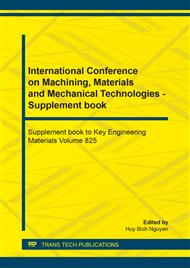p.51
p.60
p.72
p.82
p.90
p.96
p.104
p.112
p.126
A Best Practice Guideline for Inspecting Precision Machined Parts by Using Several Coordinate Measuring Machines (CMMs)
Abstract:
Currently in Thailand, original equipment manufacturers (OEM) who produce precision-machined parts face a serious problem about product rejection from customers. This is because measuring results from the OEM supplier differ from the measuring results from the OEM buyer. Normally, for precision-machined parts, OEM suppliers and OEM buyers use CMM machines as an inspection tool. One major cause of the difference in measurements is that suppliers and buyers use different CMM machine, operators and measuring methods. In order to mitigate the difference in measurements, the standard guideline for measuring precision-machined parts by CMM machines needs to be improved. In this research, the guideline was developed by studying the best practices of five successful companies, who could minimize rejection due to the differences in the CMM machine operators and measuring methods. Validation results indicated that when manufacturers who had precision problems used this guideline, the product rejection could decreased significantly.
Info:
Periodical:
Pages:
90-95
Citation:
Online since:
September 2019
Authors:
Keywords:
Price:
Сopyright:
© 2019 Trans Tech Publications Ltd. All Rights Reserved
Share:
Citation:


